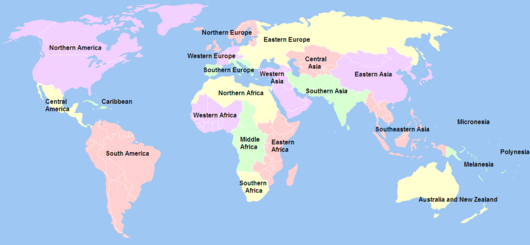Subregion
A subregion is a part of a larger region or continent and is usually based on location. Cardinal directions, such as south or southern, are commonly used to define a subregion.
United Nations subregions

The Statistics Division of the United Nations (UN) is in charge of the collection, processing, and dissemination of statistical information for the UN.[1] In 1999, it developed a system of macro-geographical (continental) regions, subregions, and other selected economic groups to report advances towards achieving numerous millennial development goals worldwide. These statistical divisions were devised for statistical purposes and is used for carrying out statistical analysis.[2] The division's first publication was the book World's Women 2000: Trends and Statistics in 2000.
According to the UN, the assignment of countries or areas to specific groupings is for statistical convenience and does not imply any assumption regarding political or other affiliation of countries or territories.[3]
Subregions by continent
The following is a non-exhaustive list of subregions, arranged alphabetically by region (i.e., by continent); in the UN geoscheme, higher-level, macro-geographical regions are arranged to the extent possible according to continents.
Africa
- by the United Nations Statistics Division's geoscheme (see also: UN geoscheme for Africa):
- by geography:
- North Africa (aka Saharan Africa)
- Maghreb (aka Northwest Africa, also including Mauritania, which most geographers consider it as part of West Africa, some geographers consider Libya as part of Northeast Africa and Western Sahara as part of West Africa)
- Sub-Saharan Africa
- Central Africa (aka Congo, Middle Africa, Equatorial Africa or Tropical Africa)
- East Africa
- Horn of Africa (aka Northeast Africa, some geographers consider Egypt, Libya and Sudan as Northeast Africa instead)
- Southeast Africa (also including Botswana, Eswatini and Lesotho, which most geographers consider them as part of Southern Africa)
- Southern Africa
- West Africa (aka Guinea)
- North Africa (aka Saharan Africa)
- by physiography:
- Congo Basin
- Guinea (region)
- Sahara
- Sahel
- Sudan (region)
- Sudanian Savanna
- East Sudanian Savanna
- West Sudanian Savanna
- Sudanian Savanna
- by economics:
- African Monetary Union (AMU)
- Arab League (including some Western Asian countries)
- Common Market for Eastern and Southern Africa (COMESA)
- Common Monetary Area (CMA)
- Community of Sahel–Saharan States (CEN-SAD)
- Council of Arab Economic Unity (GAFTA) – including some Western Asian countries
- Economic Community of Central African States (ECCAS)
- Economic Community of West African States (ECOWAS)
- EMEA (including Europe and the Middle East)
- Southern African Customs Union (SACU)
- Southern African Development Community (SADC)
- Union for the Mediterranean (including most European countries and some Western Asian countries)
- by geology:
Asia
- by the United Nations Statistics Division's geoscheme (see also: UN geoscheme for Asia):
- by geography:
- Central Asia
- East Asia
- Greater China
- China
- Hong Kong (some geographers consider it as a part of Northeast Asia)
- Macau (some geographers consider it as a part of Northeast Asia)
- Mainland China (some geographers consider it as a part of Northeast Asia)
- North China (Eastern Inner Mongolia is also a part of Northeast China)
- Northeast China (aka Manchuria) – also a part of Northeast Asia
- Southeast China (excluding Central China)
- East China (some geographers include Taiwan Island, Penghu, Kinmen, the Matsu Islands, Socotra Rock, Parangcho and the Senkaku Islands in this subregion)
- South Central China
- Central China
- South China (including Hainan Island and the South China Sea Islands, some geographers also include Hong Kong and Macau in this subregion)
- Western China
- Northwest China (some geographers consider Qinghai and Xinjiang as part of Central Asia)
- Southwest China (some geographers consider Tibet as a part of Central Asia)
- South China Sea Islands (some geographers consider them as part of Northeast Asia)
- Taiwan (some geographers consider it as a part of Northeast Asia)
- China
- Mongolia (some geographers consider it as a part of Central Asia or Northeast Asia)
- Northeast Asia
- China
- Eastern Inner Mongolia
- Northeast China (aka Manchuria)
- Japan (excluding the Bonin Islands and the Volcano Islands)
- Korea
- Russian Far East (also a part of North Asia, but not a part of East Asia)
- China
- Greater China
- North Asia (aka Siberia)
- Russian Far East (also a part of Northeast Asia)
- South Asia
- Southeast Asia
- Western Asia (aka Southwest Asia)
- by physiography:
- Arabian Peninsula
- Caucasus Mountains
- Deccan Plateau
- Eurasian Steppe
- Fertile Crescent
- Himalayas
- Indian subcontinent
- Indochinese Peninsula
- Indo-Gangetic Plain
- Indus Valley
- Iranian Plateau
- Korean Peninsula
- Malay Archipelago (including New Guinea)
- Indonesian Archipelago (including New Guinea)
- Philippine Archipelago
- Mongolian Plateau
- by geopolitics:
- Asia-Pacific (APAC) – including Oceania
- MENASA (including North Africa)
- Greater Middle East (aka the MENA) – including some African countries
- Middle East (aka the Near East) – including Egypt
- Arab League (aka the Arab states) – including some African countries
- The 'stans
- Middle East (aka the Near East) – including Egypt
- Indian subcontinent
- Greater Middle East (aka the MENA) – including some African countries
- by economics:
- Arab League (including some African countries)
- ASEAN Free Trade Area
- Asia Cooperation Dialogue (ACD) – including Russia
- Asian Clearing Union (ACU)
- Asia-Pacific Economic Cooperation (APEC) – including Oceania
- Association of Southeast Asian Nations (ASEAN)
- Bamboo network
- Bangladesh, Bhutan, India, Nepal Initiative (BBIN)
- Bay of Bengal Initiative for Multi-Sectoral Technical and Economic Cooperation (BIMSTEC)
- Council of Arab Economic Unity (GAFTA) – including some African countries
- EMEA (including Africa and Europe)
- Eurasian Customs Union (ECU) – including Belarus
- Eurasian Economic Union (EEU) – including Belarus
- Greater Mekong Subregion
- Gulf Cooperation Council (GCC)
- South Asian Association for Regional Cooperation (SAARC)
- South Asian Free Trade Area (SAFTA)
- South Asia Subregional Economic Cooperation (SASEC)
- Union for the Mediterranean (including most European countries and some African countries)
- by culture:
- Eastern world
- Muslim world (aka the Islamic world)
- by religion:
- by biogeography:
Europe
- by the United Nations Statistics Division's geoscheme (see also: UN geoscheme for Europe):
- Eastern Europe – the UN includes North Asia (Siberia) and part of Central Europe (Czechia, Hungary, Poland and Slovakia) in this subregion
- Northern Europe – the UN includes the British Isles and the Baltic states in this subregion
- Southern Europe – the UN includes Slovenia (Central Europe) in this subregion
- Western Europe – the UN includes part of Central Europe (the DACH countries and Liechtenstein) in this subregion
- by geography:
- by physiography:
- by geology:
- Alpine orogeny
- East European craton
- by geopolitics:
- by economics:
- Central European Free Trade Agreement (CEFTA)
- Commonwealth of Independent States Free Trade Area (CISFTA) – including Armenia and most Central Asian countries
- Comprehensive Economic and Trade Agreement (CETA) – including Canada
- EMEA (including Africa and the Middle East)
- Eurasian Customs Union (EACU) – including Armenia and Kyrgyzstan
- Eurasian Economic Union (EAEU) – including Armenia and Kyrgyzstan
- European Economic Area (EEA) – including Cyprus
- European Free Trade Association (EFTA)
- European Single Market (including Cyprus)
- European Union Customs Union (EUCU) – including Cyprus and Turkey
- European Union–Turkey Customs Union (including Cyprus and Turkey)
- Eurozone (including Cyprus)
- North Sea Region (NSR)
- Union for the Mediterranean (UfM) – including some Western Asian countries and some African countries
- Union State
- by culture:
- Balkans
- Baltic states
- Benelux
- Mediterranean Region
- Nordic countries
- North Sea Region
- Sápmi, since 1809 divided between Finland and Sweden
- Scandinavia
- Visegrád Group
- by language:
- by religion:
- by biogeography:
- by historical division:
Americas
- by the United Nations Statistics Division's geoscheme (see also: UN geoscheme for the Americas):
- Latin America and the Caribbean
- Caribbean[4] – the UN includes the Lucayan Archipelago in this subregion
- Latin America
- Central America[4] – the UN includes Clipperton Island and Mexico in this subregion
- South America
- Northern America[4]
- Latin America and the Caribbean
- by culture:
- by economics:
North America
- by geography:
- Middle America
- Northern America
- Bermuda
- Canada
- Greenland
- Saint Pierre and Miquelon
- United States (excluding Hawaii)
- Alaska
- Contiguous United States
- Central United States
- Eastern United States
- Northern United States
- Great Lakes region (including Ontario, Canada)
- Southern United States
- Western United States (including Alaska and Hawaii)
- Northwestern United States
- Southwestern United States (some geographers include the Oklahoma Panhandle and West Texas in this subregion)
- by physiography:
- by geopolitics:
- by economics:
- Caribbean Community (CARICOM)
- Central America Free Trade Agreement (CAFTA)
- Great Lakes Megalopolis
- Mesoamerican region
- North American Free Trade Agreement (NAFTA)
- Northeast megalopolis
- Organisation of Eastern Caribbean States
- Petrocaribe
- by geology:
- Canadian Shield
- North American craton
- Slave craton
- Superior craton
- Wyoming craton
Antarctica
- by the United Nations Statistics Division's geoscheme:
- by geography:
- Antarctic and subantarctic islands
- Bouvet Island (some geographers consider it as a part of South America)
- French Southern and Antarctic Lands (excluding Adélie Land and the Scattered Islands)
- Crozet Islands (some geographers consider them as part of Africa)
- Kerguelen Islands (some geographers consider them as part of Africa)
- Saint Paul and Amsterdam Islands (some geographers consider them as part of Africa)
- Heard Island and McDonald Islands (some geographers consider them as part of Oceania)
- Macquarie Island (some geographers consider it as a part of Oceania)
- New Zealand Subantarctic Islands (some geographers consider them as part of Oceania)
- Peter I Island
- Prince Edward Islands (some geographers consider them as part of Africa)
- South Georgia and the South Sandwich Islands (some geographers consider them as part of South America)
- South Orkney Islands
- South Shetland Islands
- Mainland Antarctica
- Antarctic and subantarctic islands
Oceania
- by the United Nations Statistics Division's geoscheme (see also: UN geoscheme for Oceania):
- Australia and New Zealand – the UN includes the Elizabeth and Middleton Reefs, Lord Howe Island Group and Norfolk Island in this subregion
- Melanesia – the UN includes New Caledonia and New Guinea in this subregion
- Micronesia
- Polynesia – the UN excludes New Zealand from this subregion
- by geography:
- Australasia
- Australia (continent)
- Australia (excluding the Australian Indian Ocean Territories, Heard Island and McDonald Islands and Norfolk Island)
- Ashmore and Cartier Islands
- Coral Sea Islands Territory (excluding the Elizabeth and Middleton Reefs)
- Mainland Australia
- Tasmania (excluding Macquarie Island)
- New Guinea (also a part of Melanesia)
- Papua New Guinea (excluding Bougainville)
- Western New Guinea
- Australia (excluding the Australian Indian Ocean Territories, Heard Island and McDonald Islands and Norfolk Island)
- Australian Indian Ocean Territories
- Heard Island and McDonald Islands
- Macquarie Island
- Zealandia
- Elizabeth and Middleton Reefs
- Lord Howe Island Group
- New Caledonia (also a part of Melanesia)
- New Zealand (also a part of Polynesia)
- Norfolk Island
- Australia (continent)
- Pacific Islands
- Melanesia (some geographers consider it as a part of Australasia)
- Micronesia (some geographers include the Bonin Islands and the Volcano Islands in this subregion)
- Polynesia (including Easter Island, Hawaii, the Kermadec Islands, and Salas and Gómez Island)
- Australasia
- by human geography:
- by biogeography:
- by geology (see also: Geology of Australia):
See also
- Autonomous region
- Committee of the Regions
- Continent
- Continental fragment
- Euroregion
- Latin names of regions
- Military district
- Polar region
- Region
- Regional district
- Regional municipality
- Subcontinent
- Submerged continents
- Supercontinent
- United Nations geoscheme
.svg.png)
.svg.png)
.svg.png)
.svg.png)


.svg.png)
_political.svg.png)
.svg.png)
.svg.png)
.svg.png)